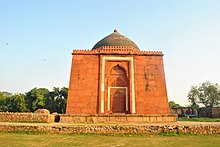Jahanpanah
Jahanpanah ( Persian : جهان jahan = "world"; پناه panah = "protection") is one of the seven or eight medieval fortresses and settlement centers that grew together over the centuries to form the Indian capital Delhi .
location
Jahanpanah is located in the South Dictrict of Delhi and borders the older settlement centers of Mehrauli , Siri and Tughlaqabad . Today the Jahanpanah City Forest takes up a large part of the eastern area. The Yamuna River passes the district approximately 10 to 15 km to the east.
history
In the years 1326/7, Muhammad bin Tughluq (ruled 1321-1351), the then Sultan of Delhi , surrounded a large district in the south of the city with the inclusion of older walls to protect against the ongoing Mongol invasions with a huge, but only partially completed Wall. Shortly afterwards, he decided to relocate the capital to Daulatabad, about 1100 km (as the crow flies) further south on the Dekkan Plateau - a decision that he had to reverse 17 years later. Most of the buildings in Jahanpanah were built after his return.
Attractions
- The Begumpur Mosque , built in the second half of the 14th century, was the largest mosque in the city in terms of area until the completion of the large Friday mosque ( Jama Masjid , around 1650/60) of the Mughal ruler Shah Jahan in the heart of today's old town of Delhi .
- At about the same time, the fortress-like Khirki Mosque was built around 2 km to the south-east, except for 4 small courtyards .
- About 800 m east of it is the Satpula Dam.
- The palace district of the Bijay Mandal emerged in the 14th century; The dating and function of the associated dome structure are controversial.
- The windowless domed structure called Lal Gumbad is the mausoleum for Cheikh Kabbiruddin Auliya, a Sufi saint who died in 1397 . The sloping outer walls are typical of the style of the Tughluq period (see also Ghiyas-ud-Din Tughluq mausoleum).
- The Yusuf Qattal Mausoleum ( Yusuf Qattal's Tomb ) was built for a Sufi scholar from Lahore. With its dark red sandstone material transported from Rajasthan , which was processed into pillars and Jali grids, it is an early building of Mughal architecture . Attached is a small - mostly plastered - mosque whose irregularly cut and differently colored stones come from the vicinity of Delhi.
Web links
- Jahanpanah - Photos + Info (English)
- Jahanpanah Photos
Individual evidence
- ^ Seven Cities of Delhi
- ↑ Jahanpanah - Khirki Mosque
- ↑ Jahanpanah - Yusuf Qattal Mausoleum
- ↑ Jahanpanah - Yusuf Qattal Mausoleum
Coordinates: 28 ° 31 '53 " N , 77 ° 13' 11" E


